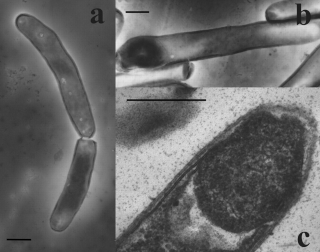
Thermus is a genus of thermophilic bacteria. It is one of several bacteria belonging to the Deinococcota phylum. Thermus species can be distinguished from other genera in the family Thermaceae as well as all other bacteria by the presence of eight conserved signature indels (CSIs) found in proteins such as adenylate kinase and replicative DNA helicase as well as 14 conserved signature proteins (CSPs) that are exclusively shared by members of this genus.
Rubrobacter is a genus of Actinomycetota. It is radiotolerant and may rival Deinococcus radiodurans in this regard.
Thermoanaerobacter is a genus in the phylum Bacillota (Bacteria). Members of this genus are thermophilic and anaerobic, several of them were previously described as Clostridium species and members of the now obsolete genera Acetogenium and Thermobacteroides
Deferribacter is a genus in the phylum Deferribacterota (Bacteria).
Dehalogenimonas is a genus in the phylum Chloroflexota (Bacteria). Members of the genus Dehalogenimonas can be referred to as dehalogenimonads.
Armatimonadota is a phylum of gram-negative bacteria.
Stigmatella is a bacterium genus in the phylum Myxococcota.
Desulfosporosinus is a genus of strictly anaerobic, sulfate-reducing bacteria, often found in soil.
Pelotomaculum is a Gram-positive strictly anaerobic, mesophilic, thermophilic and non-motile bacterial genus from the family of Peptococcaceae.

Carboxydocella is a Gram-positive and obligate anaerobe bacterial genus from the family of Syntrophomonadaceae.
Laceyella is a Gram-positive, thermophilic, spore-forming and aerobic bacterial genus from the family of Thermoactinomycetaceae. The genus Laceyella is namened after the English microbiologist John Lacey.
Planifilum is a Gram-positive and aerobic bacterial genus from the family of Thermoactinomycetaceae.
Bulleidia is a Gram-positive, non-spore-forming, anaerobic and non-motile genus from the family of Erysipelotrichidae, with one known species.
Hydrogenobacter is a genus of bacteria, one of the few in the phylum Aquificota. Type species is H. thermophilus. This genus belongs to Bacteria as opposed to the other inhabitants of extreme environments, the Archaea.
Caldanaerobacter is a Gram-positive or negative and strictly anaerobic genus of bacteria from the family of Thermoanaerobacteraceae.
Caldanaerobius is a genus of thermophilic, obligately anaerobic bacteria from the family of Thermoanaerobacteraceae.
Carboxydothermus is a genus of thermophilic, anaerobic bacteria from the family of Thermoanaerobacteraceae.
Tumebacillus is a genus of Gram-positive, rod-shaped, spore-forming bacteria. Members of the genus can be motile or non-motile, and form white or yellow colonies on R2A agar.
Effusibacillus is a genus of Gram-positive, rod-shaped, aerobic, spore-forming bacteria.
Euzebya is a genus of Gram-positive bacteria.

